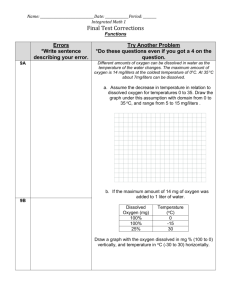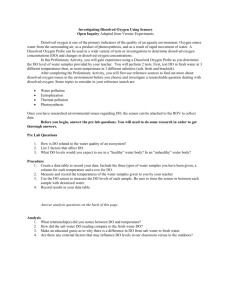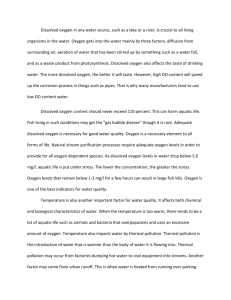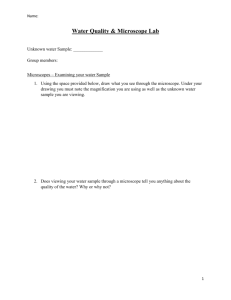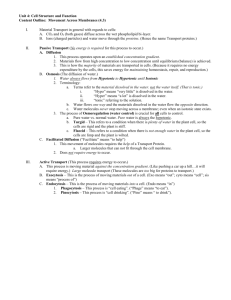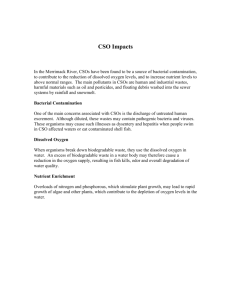Temperature & Dissolved Oxygen Lab Worksheet
advertisement
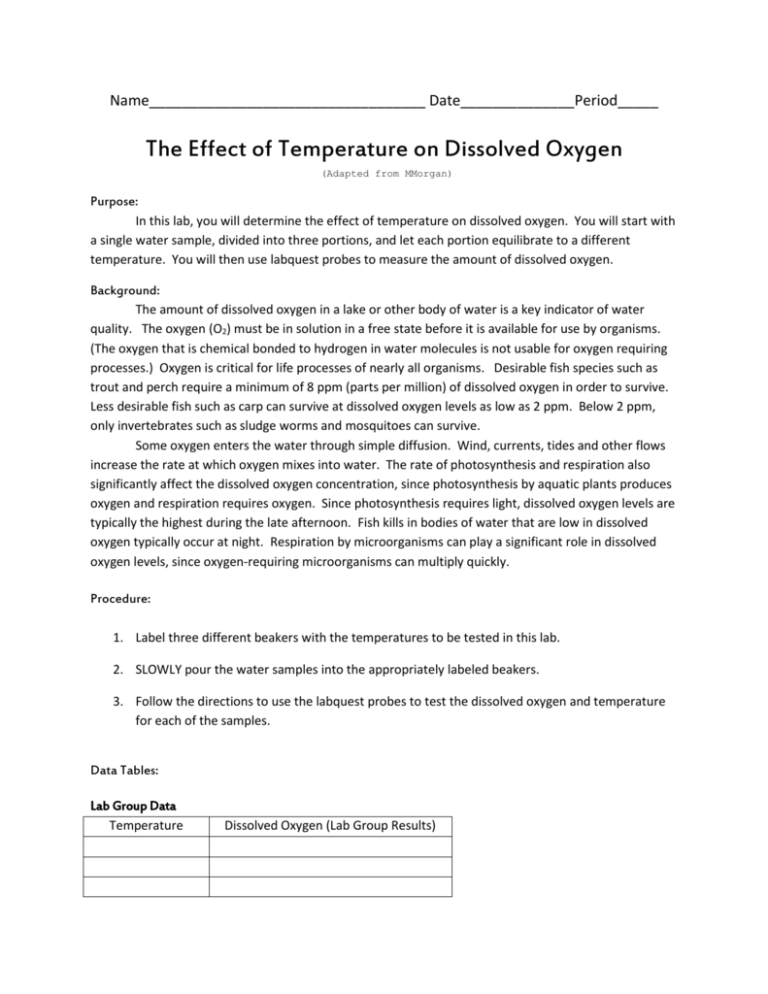
Name__________________________________ Date______________Period_____ The Effect of Temperature on Dissolved Oxygen (Adapted from MMorgan) Purpose: In this lab, you will determine the effect of temperature on dissolved oxygen. You will start with a single water sample, divided into three portions, and let each portion equilibrate to a different temperature. You will then use labquest probes to measure the amount of dissolved oxygen. Background: The amount of dissolved oxygen in a lake or other body of water is a key indicator of water quality. The oxygen (O2) must be in solution in a free state before it is available for use by organisms. (The oxygen that is chemical bonded to hydrogen in water molecules is not usable for oxygen requiring processes.) Oxygen is critical for life processes of nearly all organisms. Desirable fish species such as trout and perch require a minimum of 8 ppm (parts per million) of dissolved oxygen in order to survive. Less desirable fish such as carp can survive at dissolved oxygen levels as low as 2 ppm. Below 2 ppm, only invertebrates such as sludge worms and mosquitoes can survive. Some oxygen enters the water through simple diffusion. Wind, currents, tides and other flows increase the rate at which oxygen mixes into water. The rate of photosynthesis and respiration also significantly affect the dissolved oxygen concentration, since photosynthesis by aquatic plants produces oxygen and respiration requires oxygen. Since photosynthesis requires light, dissolved oxygen levels are typically the highest during the late afternoon. Fish kills in bodies of water that are low in dissolved oxygen typically occur at night. Respiration by microorganisms can play a significant role in dissolved oxygen levels, since oxygen-requiring microorganisms can multiply quickly. Procedure: 1. Label three different beakers with the temperatures to be tested in this lab. 2. SLOWLY pour the water samples into the appropriately labeled beakers. 3. Follow the directions to use the labquest probes to test the dissolved oxygen and temperature for each of the samples. Data Tables: Lab Group Data Temperature Dissolved Oxygen (Lab Group Results) Class Data Temperature Lab Group Data Average Data Analysis: 1. In this experiment , what is the independent (manipulated) variable? _____________________ On which axis should the independent variable be labeled? ____________________________ 2. In this experiment, what is the dependent (responding) variable? _________________________ On which axis should the dependent variable be labeled? ____________________________ Graph both your group and the class data. Be sure to correctly label the axes and include the appropriate units. Title: _____________________________________________________________________ Conclusions: 1. A. Is the relationship between temperature direct or inverse? Explain how the graph indicates this type of relationship. (If your data was inconclusive, explain any possible experimental errors.) B. What conclusion can you reach about the effect of temperature on the level of dissolved oxygen? 2. Clearly explain why temperature has this effect on the dissolved oxygen concentration. 3. List at least 2 other factors that can affect the level of dissolved oxygen in a body of water? Explain why each factor affects dissolved oxygen. 4. Some factories use water as a coolant, withdrawing water from a lake and returning it to the lake warmer than it original temperature. How would this process affect desirable fish populations, such as trout? Explain your answer. The nomogram below allows you determine the percentage saturation for the amount of dissolved oxygen in a given water sample. Percent saturation of dissolved oxygen is the amount of dissolved oxygen the water contains compared to the maximum it can hold at that temperature. Percent saturation = Actual O2 Maximum O2 x 100 Example: At 20.5 °C, the maximum amount of dissolved oxygen in water is 9 mg/L. If a sample of water contains this amount of dissolved oxygen its saturation is 100%. Whereas if a water sample only contains 4.5 mg/L of dissolved oxygen when it is at a temperature of 20.5 °C it saturation is 50%. 5. Give at least two other factors besides temperature in the lab that could have affected the saturation percentage of the water sample? Explain why might they have an effect? 6. Use the nomogram to determine the percentage saturation of each temperature of water in the lab, using the class average results. 7. Use the nomogram to compare the percentage saturation of two samples of water that both have an oxygen concentration of 5 ppm, but with temperatures of 30 °C compared to 10 °C. Explain these results. 8. What is the concentration of oxygen in water that is 100% saturated for the following temperatures: 10 °C, 20 °C and 30 °C? 9. Water going over a dam might be temporarily supersaturated with oxygen. Define the word supersaturated and explain why water might be supersaturated after it falls over a dam.

